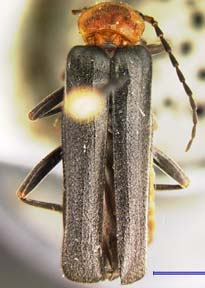
Soldier Beetles
Additional images: face view (click here), ventral view (click here).
Identification:
Cantharids are 1mm-15mm long. The form is generally broadly rounded apically, and elongate. This family contains roughly 3,500 species (Gillot, 1980). Cantharidae are very similar to the family Lampyridae (lightening bugs), and were once included in the family as the subfamily Telephorinae (Comstock, 1920). The cantharids differ in that they do not bear light-producing organs, and the head protrudes forward beyond the pronotum and is not concealed by the pronotum as in Lampyridae. They generally have yellow, orange, red, black or brown elongated, soft bodies and are typically hairy (Borror, et al. 1989).
The prothorax (1st thoracic segment, bearing the anterior legs but no wings) is without notopleural sutures. The eyes bulge outward. The antennae are 11-segmented, not elbowed, and short. The antennae are usually filiform or serrate, not clubbed (Borror, et al. 1989). The beetles in this family are unique for having a filament attached to each maxilla.
The elytra are pliable and leather-like, without reticulate sculpturing (Elzinga, 1981). The elytra are usually parallel-sided. The abdomen is with 7 or 8 visible sterna.
The tarsal segmentation is 5-5-5 (Borror, et al. 1989).
Natural History:
Cantharids are anthophilous and are commonly found on flowering plants in late summer and autumn, especially goldenrod (Comstock, 1920). Larvae are found in litter and in the soil.
Adults and larvae prey primarily on other insects. A few are omnivorous and also feed on nectar and pollen. The filament attached to each maxilla is probably used to aid in nectar and pollen collecting from flowers (Comstock, 1920).
Literature Cited:
Bland, R. G. 1978. How to Know the Insects, 3rd Edition. Dubuque, Iowa, Wm. C. Brown Company Publishers.
Borror, D. J., Triplehorn, C. A., and Johnson, N. F. 1989. An Introduction to the Study of Insects, 6th Edition. New York, Saunders College Publishing.
Comstock, J. H. 1920. An Introduction to Entomology. Binghamton, New York, Vail-Ballou Press.
Gillot, C. 1980. Entomology. New York, Plenum Press.